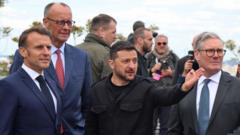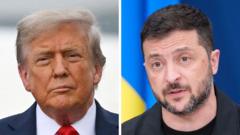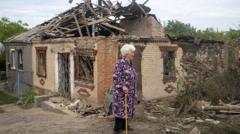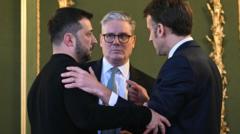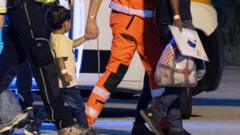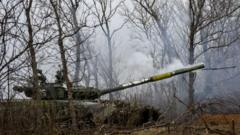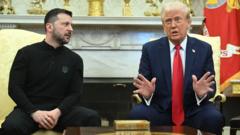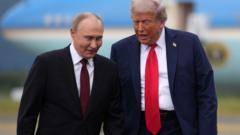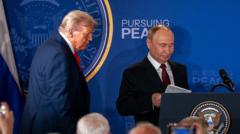Despite recent gains, military officials stress the importance of improved defenses and readiness.
Ukrainian Forces Secure Gains Against Russian Advances in Sumy Region
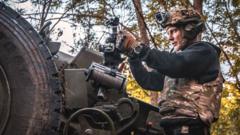
Ukrainian Forces Secure Gains Against Russian Advances in Sumy Region
Ukraine's military halts Russia's offensive, but challenges in fortification persist.
In a significant development on the northeastern front, Ukrainian forces have reportedly staved off Russian advances in the Sumy region, according to Gen Oleksandr Syrskyi, the commander of Ukraine’s army. During a field visit on Thursday, he asserted that the combat line has been "stabilised," effectively hindering what has been described as a robust Russian summer offensive. However, he highlighted a crucial need for enhanced fortifications in the area.
Syrskyi's assurance about the success in Sumy coincides with statements from other Ukrainian officials indicating that Russia’s pressure on the area appears to be waning. Yet, Border Guard spokesperson Andriy Demchenko warned that the situation remains precarious. Historically, Sumy shares a border with the Russian Kursk region, which was previously seized by Ukrainian forces in a surprising maneuver before being largely lost months later, marking a setback for Kyiv.
Following these events, Russian President Vladimir Putin announced measures to create new "security buffer zones" along the border, aimed at reinforcing areas adjacent to Ukraine's Kharkiv, Sumy, and Chernihiv regions. Reports suggest that since the spring, the Russian military has intensified its efforts in Sumy, with estimates of 50,000 troops amassed along the border aiming to establish a controlled 10km buffer zone.
Despite the successes, there have been widespread criticisms regarding the lack of fortifications in strategic hotspots. Acknowledging these concerns, Syrskyi stated that efforts to bolster defenses with 'kill zones' and anti-drone corridors are ongoing. However, he admitted that improvements need to be executed more efficiently to protect Ukrainian soldiers and ensure effective logistics.
In the early phases of the Russian invasion in February 2022, Ukraine faced significant challenges due to inadequate fortifications that allowed Russian troops to advance across multiple fronts. As of now, there are fears that the current window for establishing effective defenses in Sumy might have closed, as Moscow is aware of vulnerable points along the front line. Recent months have seen claims from Russia of captured villages and sustained missile attacks on Sumy, leading to tragic casualties, including a ballistic missile strike that claimed dozens of lives earlier this month.
Monitoring organization DeepState has reported ongoing combat in various areas lacking strong defensive positions, echoing concerns about delays in constructing vital fortifications. Addressing these issues last week, Putin remarked that while capturing Sumy is not a current objective, it remains a possibility, with Russian forces reportedly establishing a buffer zone between 8-12 km deep.
As the conflict, now in its fourth year, escalates with a rise in drone strikes against Ukrainian cities, recent diplomatic exchanges between Ukraine and Russia have resulted in substantial prisoner swaps but little progress towards a ceasefire. Amid this turbulence, NATO Secretary General Mark Rutte highlighted recent commitments of €35 billion from European and Canadian allies to support Ukraine's defense. However, uncertainties regarding U.S. support under President Trump have left Kyiv anxious. In discussions following a recent NATO summit, Trump expressed willingness to consider providing advanced US Patriot missile systems to bolster Ukraine’s defense against continuous Russian airstrikes.
Syrskyi's assurance about the success in Sumy coincides with statements from other Ukrainian officials indicating that Russia’s pressure on the area appears to be waning. Yet, Border Guard spokesperson Andriy Demchenko warned that the situation remains precarious. Historically, Sumy shares a border with the Russian Kursk region, which was previously seized by Ukrainian forces in a surprising maneuver before being largely lost months later, marking a setback for Kyiv.
Following these events, Russian President Vladimir Putin announced measures to create new "security buffer zones" along the border, aimed at reinforcing areas adjacent to Ukraine's Kharkiv, Sumy, and Chernihiv regions. Reports suggest that since the spring, the Russian military has intensified its efforts in Sumy, with estimates of 50,000 troops amassed along the border aiming to establish a controlled 10km buffer zone.
Despite the successes, there have been widespread criticisms regarding the lack of fortifications in strategic hotspots. Acknowledging these concerns, Syrskyi stated that efforts to bolster defenses with 'kill zones' and anti-drone corridors are ongoing. However, he admitted that improvements need to be executed more efficiently to protect Ukrainian soldiers and ensure effective logistics.
In the early phases of the Russian invasion in February 2022, Ukraine faced significant challenges due to inadequate fortifications that allowed Russian troops to advance across multiple fronts. As of now, there are fears that the current window for establishing effective defenses in Sumy might have closed, as Moscow is aware of vulnerable points along the front line. Recent months have seen claims from Russia of captured villages and sustained missile attacks on Sumy, leading to tragic casualties, including a ballistic missile strike that claimed dozens of lives earlier this month.
Monitoring organization DeepState has reported ongoing combat in various areas lacking strong defensive positions, echoing concerns about delays in constructing vital fortifications. Addressing these issues last week, Putin remarked that while capturing Sumy is not a current objective, it remains a possibility, with Russian forces reportedly establishing a buffer zone between 8-12 km deep.
As the conflict, now in its fourth year, escalates with a rise in drone strikes against Ukrainian cities, recent diplomatic exchanges between Ukraine and Russia have resulted in substantial prisoner swaps but little progress towards a ceasefire. Amid this turbulence, NATO Secretary General Mark Rutte highlighted recent commitments of €35 billion from European and Canadian allies to support Ukraine's defense. However, uncertainties regarding U.S. support under President Trump have left Kyiv anxious. In discussions following a recent NATO summit, Trump expressed willingness to consider providing advanced US Patriot missile systems to bolster Ukraine’s defense against continuous Russian airstrikes.

